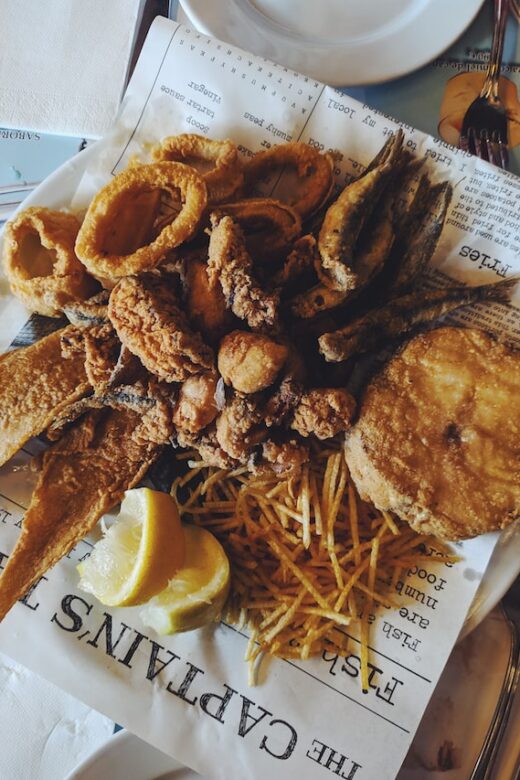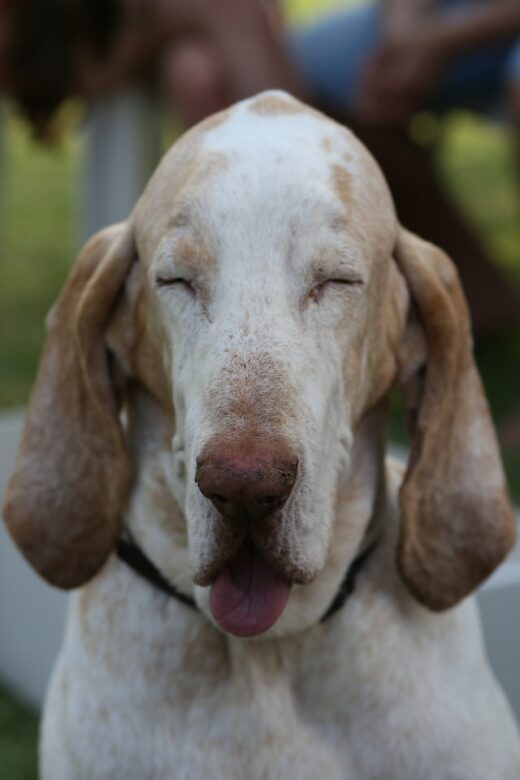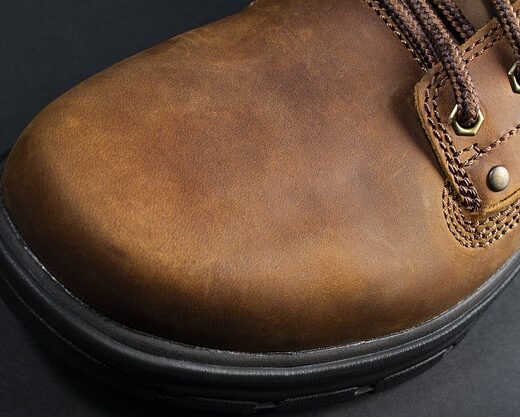If you’re just joining us, check out Part 1.
The first time the term “hush puppies” made national headlines, it was because of several tourists who were fishing in Florida. A trip report on central Florida was published in 1934 by the Pennsylvania newspaper Harrisburg Sunday Courier. The author had gone fishing at Mr. Joe Brown’s camp on Lake Harris near Orlando. The author claimed that “Brown can cook,” and his lunch included fried delicious cornbread innovation by Brown called “Hush Puppies.”
American Cookery, American Legion Magazine, and Boy’s Life soon began publishing hushpuppies, and National Scout Commission Dan Beard devoted one of his monthly features to his Key West fishing trip. He was a “hush-puppy expert,” the author of Mrs. J. G. Cooper’s “recognized recipe.” A batter made of one quart of white water-ground cornmeal, two eggs, three teaspoons of baking powder, and one teaspoon of salt was fried in the same pan as the fish.

The cutesy stories frequently undersell the quality of traditional Southern foods, depicting them as examples of cooks making the best of inexpensive, modest materials, as we’ve seen with other Southern culinary origin myths, such as chicken and dumplings. Early accounts of hushpuppies and red horse bread, however, demonstrate that diners view this new dish as a low-cost substitute but rather as a luxury worthy of praise.
Origin of Hush Puppies
Let’s look at the term “hushpuppy” and try to determine where it originated. Many of the theories regarding the word’s origin seem to start with the name and then infer a narrative from there. Some even go so far as to use the “shut up, dog” tale to explain not only the dish’s name but also how it came to be.
The innovation was created by a Florida cook who became tired of hearing dogs weep when they smelled cooked fish, according to a 1939 article in the Capital Times of Madison, Wisconsin. According to the author, “she cooked up a batch of corn cakes to give the hounds, in desperation to calm the puppies, and after sampling them, discovered they were quite excellent eating herself.”
As was previously said, the term “hushpuppy” predates deep-fried cornbread. Surprisingly, the word “hushpuppy” predates the dish made of fried cornmeal.

The phrase was employed to cover up or mute someone as early as the 18th century. According to a report from 1738, dishonest British officials who were ordered to board and search a ship suspected of smuggling “played the Game of Hush-Puppy,” delaying their search while they listened to music in the captain’s cabin for several hours. By the time they resumed their search, the crew had hidden the contraband beneath the ship’s ballast.
The word crossed the Atlantic and, until the early 20th century, was connected with dishonesty. For instance, several newspaper articles on the Teapot Dome affair in 1924 blasted the Harding administration’s “hush-puppy techniques of allowing this scandal to fester and thrive” and warned that “we hope the Republicans won’t be able to hush puppy the oil transaction as easily.”
The Texas Tale
The name “hushpuppy” originally referred to either gravy or pot liquor before cornmeal. The San Antonio Herald reported in 1879 that Jim Gillet of Lampass Springs had a human scalp covering his gun holster. After murdering eight Native Americans with a group of Texas Rangers in “a rapid skirmish with Winchester rifles against wooden arrows,” he had taken it as a souvenir. A few months later, Gillet was having breakfast while “leaning over a frying pan” when “he dragged the long hair into the ‘hush puppy’ gravy.” The scalp was immediately thrown into the flames and set on fire.

A soldier is quoted as saying, “Had breakfast hours ago, you know, and a fine one it was,” in an 1899 Spanish-American War narrative. Drugs without milk, hush puppies, slumgullion, and such foolishness.” I sop my bread with hush-puppy, the American Speech journal’s description of “hush-puppy” as “Ham gravy” in 1939.
Keeping dogs calm was another use for this term. The Mississippi senator H. H. Casteel stated in 1915 that “pot-liquor” was called “hush-puppy” in his district because it prevented “hound dawgs” from growling. It’s unclear if he meant actual dogs or a person’s stomach, but given that cannabis has many culinary uses, it seems unlikely that people would pour bowls of cannabis liquor for their pets to drink.
Have actually fried cornmeal batter balls ever been thrown to calm down real dogs? I highly doubt it, especially in light of how highly early hushpuppies eaters appeared to value the snack, and it would take a truly kind dog owner to let the dog enjoy such a luxury. It seems that the phrase “quiet puppy” was really a way to stop the dogs in your stomach from growling.
In addition to “red horse bread,” Floridians also referred to what we now refer to as hushpuppies as “wampus,” and Georgians called them “red devils” and “three finger bread .”However, “hushpuppy” persisted. By the 1940s, hushpuppies were being offered at seafood restaurants that catered to beachgoers and visitors heading down U.S. 17 toward Florida with fried fish and steamed oysters.
Walter Thompson, a businessman from Swansboro, North Carolina, wanted to advertise hushpuppies all throughout the country in 1948. Cornmeal, flour, and spices were combined to make Thompson’s Fireside Hushpuppy Mix, which was then put into pasteboard tubes. “Just add water,” read the label. “A tasty and distinctive Southern hot bread.” Each can cost 30 cents.
The Shoes
The Hushpuppy Corporation of America was the name of Thompson’s business. He formed alliances with distributors all throughout the South, but his big break came when he signed a deal with Westfield, New Jersey-based John R. Marple & Co., which became the product’s national distributor and promoted it through a series of newspaper and radio advertisements.
A year after the company’s launch, Thompson sold the Hushpuppy Corporation of America to a group of investors, who then moved the business to the bigger city of Jacksonville, North Carolina. It was possible to buy Thompson’s Fireside Hushpuppy Mix for at least another two decades. Hushpuppy Corporation of America was bought in by House-Autry Mills of Four Oaks, North Carolina, in 1970. They still market the Original Hushpuppy Mix.
What about the renowned “hushpuppy” footwear? They were indeed named after a Southern side dish for a fish fry. The Wolverine Shoe and Tanning Corporation created a soft rubber-crepe sole after the Second World War using a newly developed method for making brushed pigskin. The company’s history reports that one of its salesmen was eating fried catfish and hushpuppies when he was told the (claimed) origin story of the fried fritter while on a sales trip to the South. He thought the moniker was perfect for a pair of sneakers that would “quiet your boisterous pets.” In America, Hush Puppies were the first non-athletic casual shoes, making their debut in 1957. By 1963, it was estimated that one in ten people owned a pair.

I’d rather eat a hushpuppy than wear one, though. Found everywhere, from Mel’s Fish Shack in California and Snappy’s Shrimp in Illinois, straightforward hushpuppies are now accessible. As is their custom, chefs are cheffing things up. At the Early Girl Eatery in North Carolina, You can find roasted corn hushpuppies with pimento cheese fondue. For an upscale selection, visit Vintage Twelve in South Carolina, where you’ll find broccoli cheddar hushpuppies with creamy garlic sauce.
This versatile Southern icon is capable of withstanding any amount of enhancement and attention. For laughs, I wouldn’t mind if eateries once more referred to them as “red horse bread.
If you’ve never tried them, find yourself an authentic Southern restaurant. Order a mess of greens, some fried catfish and a basket of fresh, hot hush puppies. Let me know what you think!


Leave a Reply